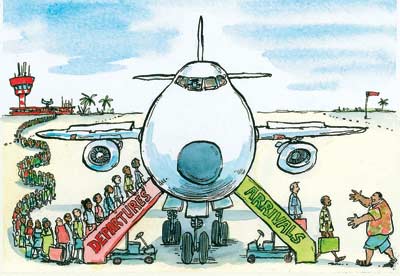 The link between poverty and terrorism is well-known. In theory, one of the purposes of organizations like USAID is to complement the other “D’s” of the foreign policy apparatus – diplomacy and defense – to improve conditions for people most likely to be driven to desperation: the poor. It is not surprising that the hotbeds of terrorism today – Afghanistan, Yemen, Somalia, Pakistan, Indonesia – happen to be some of the poorest countries in the world. Nor is it surprising that many of these countries receive the lion’s share of foreign aid from the U.S. government, despite their apparent animosity toward the country. The Nesaji cotton-and-wool factory in Kandahar is a perfect metaphor for the complex forces working against development efforts. Built by Iran and the Soviet Union in 1971 and maintained by a motley crew of warlords and foreign countries, including its current steward, the United States, the factory has operated for only 60 days throughout its 40-year history. Governments are not the only ones concerned about the causal relationship between poverty and terrorism.
The link between poverty and terrorism is well-known. In theory, one of the purposes of organizations like USAID is to complement the other “D’s” of the foreign policy apparatus – diplomacy and defense – to improve conditions for people most likely to be driven to desperation: the poor. It is not surprising that the hotbeds of terrorism today – Afghanistan, Yemen, Somalia, Pakistan, Indonesia – happen to be some of the poorest countries in the world. Nor is it surprising that many of these countries receive the lion’s share of foreign aid from the U.S. government, despite their apparent animosity toward the country. The Nesaji cotton-and-wool factory in Kandahar is a perfect metaphor for the complex forces working against development efforts. Built by Iran and the Soviet Union in 1971 and maintained by a motley crew of warlords and foreign countries, including its current steward, the United States, the factory has operated for only 60 days throughout its 40-year history. Governments are not the only ones concerned about the causal relationship between poverty and terrorism.
Here in Kenya, an organization called Nuru International, founded by former special ops marine Jake Harriman, is pilot-testing a holistic community-based development model. Its mission is to end terrorism by ending extreme poverty. The connection is not difficult to make. For people living hand-to-mouth, life is a series of struggles often ending in tragedy. Anger, resentment, and despair are a volatile combination in the minds of young men and women who see little hope for escaping their situation. For recruiters of organizations like Boko Haram and the Al-Shabab – literally translated as “The Youth” – these young minds can be manipulated to pick up arms. By stoking latent frustrations at the injustice of poverty and promising a sense of a community, brotherhood, and commitment to a higher cause, a recruiter can more easily convince a teenager to become a suicide bomber.

A member of Boko Haram.
This anger and frustration is compounded by a sense of injustice. When the gap between rich and poor is vast, the impoverished majority are more likely to consider their situation as a function of either indifference or criminality by those controlling the wealth. It is under these circumstances that the fledgling Nigerian terrorist group, Boko Haram, has grown.
Boko Haram has killed more than 900 people since 2009, including perpetrating a massacre last month that left 300 people dead in Kano, the capital of the Kano state in Northern Nigeria. As an Islamic fundamentalist group with ties to Al-Qaeda in the Islamic Maghred, the North African faction of the jihad organization, Boko Haram is a growing concern for Western security analysts. But according to some on the ground in Kano, the group’s motivations are simpler. In an article titled, “In Nigeria, a Deadly Group’s Rage Has Local Roots,” Adam Nossiter explains the situation on the ground:
For now, Boko Haram’s targets remain largely local, despite its bombing of a United Nations headquarters in Abuja, the capital, last summer. The Nigerian state is typically the enemy, and many analysts see the nation’s enduring poverty as one reason. This month figures were released in Abuja indicating that poverty has increased since 2004, despite the nation’s oil wealth; in the north, Boko Haram’s stronghold, about 75 percent of the population is considered poor. Overall, 60 percent live on less than $1 a day. Every citizen appears aware of the glaring contrast between his or her own life and those of the elite.
Ado Ibrahim, a 22-year-old sugar cane vendor wearing a yellow soccer jersey, suspected more violence could be ahead. “Injustice, and misgovernance by officials,” he said, adding, “It’s possible, as long as injustice persists, it’s possible to have another flare-up.”
Down the street, squatting in his open-air stall where he sells cooked yams, Abdullahi Dantsabe had a similar point of view. Why had the attacks occurred? “Injustice,” he said. “The leaders are not concerned about the common man.”

A Yemeni man sits by the wreckage of tourists' cars at the site of a suspected al-Qaeda car bomb attack in Marib in July 2007. Photograph: Khaled Abdullah/Reuters
Nigeria is one of the most corrupt countries in the world. The Corrupt Perceptions Index, which is a measurement of how people view their government, ranks Nigeria 143 out of 180. A Nigerian friend of mine once explained to me the concept of “bunkering,” which is when a businessman – usually someone with military connections at the highest levels or a general himself – connects a pipe to a much larger oil pipeline in order to siphon the product and sell it on the black market. Add to this dynamic massive income inequality and ethnic tensions throughout the country (but mainly on situated on a north-south divide), and the elements that typically fuel the growth of groups like Boko Haram seem to be in place.
In fact, most of the countries today where Islamic fundamentalism is on the rise are generally poor and massively unequal with highly corrupt governments. In Africa, Chad (168), Sudan (177), Niger (134), and Somalia (180), which holds the dubious distinction of last place, are all areas where for terrorist organizations have flourished. In the Middle East and South Asia, Pakistan (134) and Yemen (164) are considered some of the most dangerous countries in the world.
I am not saying that terrorist organizations develop due to circumstances alone. At the highest levels of these organizations are typically rich and educated planners, who are misguided, at best, or sociopathic. Osama bin Laden was the son of a wealthy Saudi construction magnate, and many of Al-Shabab’s top leadership hail from countries outside Somalia – including one, Omar Hammami, AKA Abu-Mansoor al-Amriki, who grew up in Alabama. But the soldiers – the grunts on the ground who are blowing themselves up along with innocents around them – are disproportionately drawn from the poor underclass, the idle youth with few prospects for employment.
It is these people who economic development programs aim to help. Whether they are successful is a different question. In the case of the Nesaji cotton-and-wool factory in Kandahar, the answer is clearly no.
Develop Economies’ Music Recommendation

 The flagship of the Sachs camp is the Millenium Villages project, a $150 million, multi-country intervention that exemplifies the concept of “the big push.” The systems that underlie the poverty trap are extraordinarily complex, layered, and multi-faceted. According to the top-down school of thought, it is possible to change the entire system only by changing its key components. The Economist
The flagship of the Sachs camp is the Millenium Villages project, a $150 million, multi-country intervention that exemplifies the concept of “the big push.” The systems that underlie the poverty trap are extraordinarily complex, layered, and multi-faceted. According to the top-down school of thought, it is possible to change the entire system only by changing its key components. The Economist  In order to do anything, you have to do everything. Being on the ground, you see the complexities of the system at work. Everything is interrelated and connected in a complex web. Change an input here or there and you can transform the system. But, more often, well-reasoned tweaks to the system have unintended consequences. What is more, it is question whether even the smartest economists can truly comprehend that sheer magnitude of the forces at play. They are, after all, global by nature.
In order to do anything, you have to do everything. Being on the ground, you see the complexities of the system at work. Everything is interrelated and connected in a complex web. Change an input here or there and you can transform the system. But, more often, well-reasoned tweaks to the system have unintended consequences. What is more, it is question whether even the smartest economists can truly comprehend that sheer magnitude of the forces at play. They are, after all, global by nature. When I moved to Nairobi, I did not really know what to expect. I’d been here once before and moved on a whim. Fortunately, in the first week, I discovered the
When I moved to Nairobi, I did not really know what to expect. I’d been here once before and moved on a whim. Fortunately, in the first week, I discovered the  I actually think that these principles are not only intuitive, but really fundamental to solving any problems. In a social innovation context, the most basic example of how design thinking is not applied is in stereotypical top-down development projects that seek to apply theoretical generalities in addressing a problem, while ignoring the local context. Some might claim that
I actually think that these principles are not only intuitive, but really fundamental to solving any problems. In a social innovation context, the most basic example of how design thinking is not applied is in stereotypical top-down development projects that seek to apply theoretical generalities in addressing a problem, while ignoring the local context. Some might claim that  Human capital flight – otherwise known as “
Human capital flight – otherwise known as “ Microsoft is only one example. The company and industry are secondary to the work environment, which emphasizes the importance of intangibles, like time management, prioritization of tasks, and quality control. Working for an American company like General Electric, for example, might teach someone the importance of optimization in manufacturing, while working for Target shows them the importance of customer service in maintaining client relationships. Then, when they return to their home countries and start their own business, they bring with them those industry-specific best practices. As a result, they are more competitive in the domestic market, forcing competitors to either adapt or die. Ultimately the economy becomes stronger and more competitive.
Microsoft is only one example. The company and industry are secondary to the work environment, which emphasizes the importance of intangibles, like time management, prioritization of tasks, and quality control. Working for an American company like General Electric, for example, might teach someone the importance of optimization in manufacturing, while working for Target shows them the importance of customer service in maintaining client relationships. Then, when they return to their home countries and start their own business, they bring with them those industry-specific best practices. As a result, they are more competitive in the domestic market, forcing competitors to either adapt or die. Ultimately the economy becomes stronger and more competitive.


